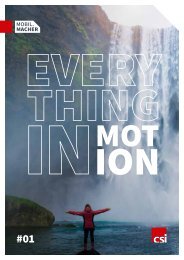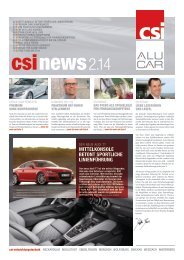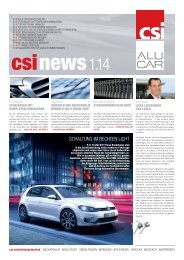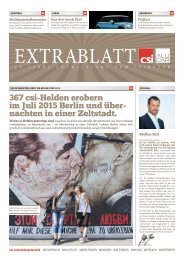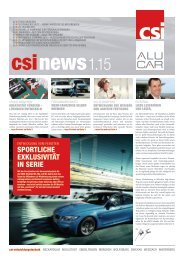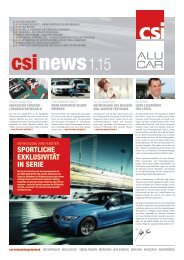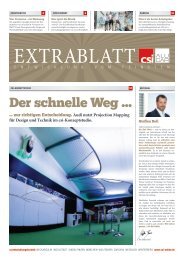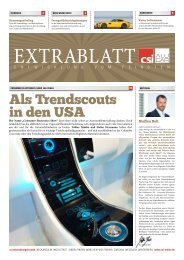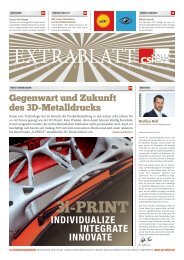csi Newsletter 2022 english
Create successful ePaper yourself
Turn your PDF publications into a flip-book with our unique Google optimized e-Paper software.
08 | ma<strong>csi</strong>_mum | <strong>2022</strong><br />
CRASH STRUCTURES IN ELECTRIC VEHICLES<br />
HEAD-<br />
ON<br />
A head-on collision with an electric vehicle. That could be a horror scenario.<br />
Or, as in our case, an interesting and successful joint project with acs, Automotive Center<br />
Südwestfalen GmbH. Together with eleven further collaborative partners, we, that is ALU-CAR,<br />
considered the differences in the body works of electric vehicles compared to combustion<br />
engine models in accidents. The entire project was entitled "LACEF – Load path appropriate<br />
design of crash structures in electric vehicles". The fact that there is no solid engine block<br />
with electric drives changes the fundamental conditions and structures. The vehicle weight<br />
thus increases due to the traction battery, and the centre of gravity shifts. Apart from developing<br />
innovative concepts, the focus within the project body was also on achieving a fundamental<br />
understanding of crash-relevant structures in the frame vehicle front. We think we achieved –<br />
together with the 11 other companies involved and acs, which was responsible for the project –<br />
and were able to contribute towards developing interesting approaches.<br />
INTELLIGENT MIXED AND<br />
LIGHTWEIGHT CONSTRUCTION:<br />
ESSENTIAL IN ELECTRIC<br />
VEHICLES.<br />
ACCIDENT-FREE:<br />
FROM COMBUSTION VEHICLES<br />
TO ELECTRIC MOBILITY.<br />
The objective of the project was to understand<br />
HALF A DOZEN IDEAS.<br />
Twelve project partners, six concepts – that’s a<br />
good average and it shows that there is more<br />
than one correct answer or solution in struc-<br />
A plethora of new ideas and contacts resulted<br />
from the cooperation with companies and experts<br />
from various sectors, from which we at<br />
ALU-CAR will also certainly benefit. That is why<br />
We need to take into account the altered general<br />
the altered conditions in electric vehicles and<br />
ture optimisation as well. You can reach the<br />
we would like to thank acs for the opportunity<br />
conditions to enable people to walk away from<br />
develop alternative load path concepts with<br />
goal along different paths, depending on your<br />
to be involved in this joint project, as well as all<br />
a crash in an electric car unscathed. That means<br />
the help of simulation models. To do this, an FE<br />
preferred designs, materials and manufactur-<br />
the project partners for the truly constructive<br />
that the hollow cavity, that is the area in which<br />
model of a real combustion engine vehicle was<br />
ing technologies. In the Automotive Center<br />
time.<br />
the engine block would usually be mounted,<br />
converted into a simple electric model then and<br />
Südwestfalen GmbH LACEF project, two differ-<br />
needs to be filled or stabilised in another way.<br />
there. It was clear even from the first investiga-<br />
ent concepts with a comparable crash perfor-<br />
If you would like to find out more about this pro-<br />
That is also best accomplished in this case with<br />
tions: the structures of the vehicle front of an<br />
mance were ultimately implemented and de-<br />
ject, more information and a short video about<br />
sound knowledge and experience. We are ex-<br />
electric vehicle experience significantly higher<br />
veloped in detail as the project progressed. The<br />
the two concepts can be viewed<br />
perts in materials, joining techniques and ma-<br />
loads in a crash than combustion engine models<br />
main load path in the two alternatives varies<br />
at the following link: www.<br />
terial interfaces, as we have already developed<br />
in which the engine block absorbs much of the<br />
while the lower and upper support load paths<br />
acs-innovations.de/leistungen/<br />
body concepts for different types of drive as an<br />
energy. No surprises there, but this represent-<br />
are identical.<br />
verbundprojekte/lacef<br />
established vehicle developer and lightweight<br />
ed the initial basis for finding alternatives in a<br />
construction specialist. Of course, we were<br />
multi-stage development process. A total of six<br />
Concept I involves extruded aluminium profiles<br />
more than happy to apply this knowledge and<br />
possible concept drawings were developed with<br />
which form a framework structure, an approach<br />
expertise to the joint LACEF project and look at<br />
the help of FEM analysis, which determines the<br />
that could be described as traditional. Concept<br />
"design work" in our role as project partner. We<br />
fatigue strength and deformation of solid bod-<br />
II is clearly more unconventional: it involves an<br />
were also available to the other project stake-<br />
ies with a geometrically complex shape, cou-<br />
innovative sandwich sheet steel structure which<br />
holders in an advisory capacity for crash design.<br />
pled with various optimisation programmes.<br />
absorbs the impact energy and meets the speci-<br />
These initial, rough designs were compared<br />
fied target parameters.<br />
and discussed with the experts and companies<br />
involved.<br />
SEBASTIAN OCHSENFELD,<br />
LACEF PROJECT MANAGER




